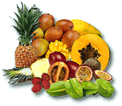
June 2005
The Daley News
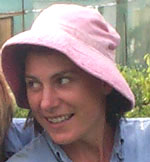 It is that time of the year again when we all enjoy the pecan feast. We have had several reasons to celebrate in the past few weeks. There has been a new addition to our nursery family with the birth of a son to Tara and Adam. They have named him Costa and they are all doing well if lacking a little sleep. We are already missing Tara who you will all know from her contributions to the newsletter and her bright happy voice on the end of the phone. Greg celebrated his 50th birthday with a win in the ping-pong competition and a chocolate bliss pecan pie enjoyed by us all. Many happy returns from us all and may your next half century be as fruitful as your first one.
It is that time of the year again when we all enjoy the pecan feast. We have had several reasons to celebrate in the past few weeks. There has been a new addition to our nursery family with the birth of a son to Tara and Adam. They have named him Costa and they are all doing well if lacking a little sleep. We are already missing Tara who you will all know from her contributions to the newsletter and her bright happy voice on the end of the phone. Greg celebrated his 50th birthday with a win in the ping-pong competition and a chocolate bliss pecan pie enjoyed by us all. Many happy returns from us all and may your next half century be as fruitful as your first one.
 We have been enjoying the recent rains that have certainly changed the season for us, the heat and humidity of summer have gone and this is my favourite time of the year to be planting trees. We now have a little time to do the jobs that we have put off for a rainy day. We are cleaning, regrouping, making space and putting the cold sensitive stock into warmer places. I would also like to introduce Jude Fanton from the Seed Savers who is contributing a wonderful article in this months newsletter, I am sure you will all find it very inspiring.
We have been enjoying the recent rains that have certainly changed the season for us, the heat and humidity of summer have gone and this is my favourite time of the year to be planting trees. We now have a little time to do the jobs that we have put off for a rainy day. We are cleaning, regrouping, making space and putting the cold sensitive stock into warmer places. I would also like to introduce Jude Fanton from the Seed Savers who is contributing a wonderful article in this months newsletter, I am sure you will all find it very inspiring.
Story of the Month
Seed Savers
Expo of Edible and Useful Plants
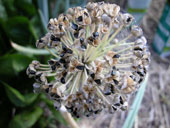 “The Seed Saver’s Garden” at Byron Bay will be open on Saturday 11th and Sunday 12th June under the Australia’s Open Garden Scheme.
“The Seed Saver’s Garden” at Byron Bay will be open on Saturday 11th and Sunday 12th June under the Australia’s Open Garden Scheme.
A sign in the garden reading “Why Mow Where Food Can Grow?”, aptly summarises one of the aims of this garden - to encourage gardeners and farmers alike to produce pesticide-free food with nourishing and healing qualities, in an environmentally friendly way.
To this end, Michel and Jude Fanton have created a garden overflowing with edible plants whose seeds are collected for the ever-increasing seed bank. They created The Seed Savers' Network, a non-profit organisation, in 1986, not only to collect seeds of diminishing traditional food sources, but also to educate others in seed saving practices, and to share this information not only in Australia but also in Africa, The Pacific, The Middle East, Asia and South America. Seed Savers promotes and organises the preservation, free distribution and exchange of open-pollinated seeds
The seven year old garden is set on an acre of sweeping lawns just two kilometres south of the centre of Byron Bay. Designed with low maintenance Permaculture methods in 1998, the terraces are planted with ethnobotanically diverse vegetables, herbs, edible shrubs and fruits from around the world. There are unusual or uncommonly grown plants such as the Annatto Bixa orellana the lipstick plant, tea, cinnamon, the Peanut Butter Tree Bunchosia argentea, fiteen varieties of bananas including Pacific Plantain, Blue Dukas and Red Dacca, Betel Pepper Piper sarmentosum, Areca triandra whose green nuts are used for chewing like Betel, and Silk Floss Tree Chorisia speciosa whose seed pod fluff is used to stuff pillows. There are a dozen clumping bamboos, including Dendrocalamus latiflorus, Bambusa oldhamii and Dendrocalamus membranaceous that have edible shoots and Nastus elatus that originates in the highlands of New Guinea and is one of the few bamboos whose shoots are edible raw.
The orchard has been cleverly arranged into Mediterranean, Asian, Pacific and American sections, illustrating the origins of commonly used plants, with plants clearly labelled, sometimes in the most innovative and original ways.
The Fruity Forest is a lush part of the garden that thrives without any watering system due to Permaculture principles of growing mulch trees in between the fruit trees.
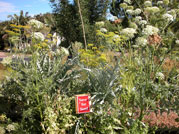 If you are interested in growing your own herbs, this is the place to observe successful methods, with raised beds filled with coriander, several varieties of thyme, oregano, sage, winter savoury, garlic, basil, comfrey and fennel.
If you are interested in growing your own herbs, this is the place to observe successful methods, with raised beds filled with coriander, several varieties of thyme, oregano, sage, winter savoury, garlic, basil, comfrey and fennel.
One new feature of the garden is an area along the railway line dubbed the Hanging Gardens of Babylon (in memoriam). It is a diverse learning environment full of interesting, delicious plants.
Many of the perennials have signs with their common and botanical names, usage and continent of origin depicted on rocks, timber, pottery and metal. Garden guides will be available for consultation in every section of the garden making this a marvellous learning opportunity for young and old alike.
Delicious morning and afternoon teas will be available sensationally good for us all. You can even pick a plate for your morning tea from the Burmese Bayur, Pterospermum acerifolium. Seed produced on site will be available to buy along with seedlings grown from Seed Savers' seeds and books on gardening and seed saving.
Local ABC radio will be broadcasting its garden programme from 8.30am to 10am from the site, with Gardening Australia presenter Jeremy Coleby-Williams in attendance.
Other current Seed Savers projects are:
Encouraging Seed to Seed Food Gardening in Schools
With the crisis in obesity, something fast needs doing about children's eating habits. Seed Savers sees a thriving food garden in every school as imperative. The ideal would be gardens planted with traditional local varieties. To this end Seed Savers is producing a book for teachers on how to establish a food garden and plant it from seed, and then how to continue each year to collect seeds and replant them.
Establishing Local Seed Networks around Australia
Since 2001, Seed Savers has been devolving into Local Seed Networks that collect and redisseminate local varieties of useful plants. This process was begun on the principal that local varieties are adapted to local conditions and will therefore need less care and intervention. To date there are sixty such networks around Australia.
Helping to Establish Seed Networks in other Countries
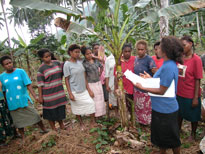 Seed saving groups have started up in several countries with help from Seed Savers. Familiar to customers would be Emma Stone who worked with Daley's from 2001 to 2004 and is now working in the Solomons where the Planting Material Network to conserve traditional varieties of food plants was established in 1995 with Seed Savers assistance. Emma has volunteered with them over the years.
Seed saving groups have started up in several countries with help from Seed Savers. Familiar to customers would be Emma Stone who worked with Daley's from 2001 to 2004 and is now working in the Solomons where the Planting Material Network to conserve traditional varieties of food plants was established in 1995 with Seed Savers assistance. Emma has volunteered with them over the years.
Seed Savers interns have helped to start seed networks in Japan, Ecuador and Argentina and have helped existing networks in Bali, India and Cambodia. Jude and Michel helped start networks in Africa, Ecuador, Columbia and Afghanistan. They advise and donate their Seed Savers' Handbook to be translated into other languages and adapted to local conditions - so far in the UK, Japan, Bulgaria, Italy and soon Ecuador and Cuba.
Building an Education Centre
Building of an education centre on-site is scheduled to commence in the next year. It will house Seed Savers offices, seed bank, display room, ethnobotanical library, and teaching facilities. There will then be courses on gardening and seed production as well as on how to use all those plants in the garden.
Researching Inter-Varietal Nutritional Levels
There is evidence that traditional varieties of fruits and vegetables have higher nutrition than modern commercial varieties. Seed Savers continuously collects scientific reports on this issue.
With heightened awareness of the nutritional value of food that is home-grown from traditional varieties, The Seed Savers' Network offers a comprehensive pool of techniques and information to continue the production of traditional food varieties. Another garden sign,“Let Your Garden Be Your Medicine” says it all!
The garden is open from 8.30am until 3.30pm with an entry fee of $5.00 (inc. GST) for adults,and children under 18 are free. For directions contact your local tourist office, or phone 1902 261 026 and select 2.
Fruit Tree of the Month
The First Harvest – Rods Pecan Farm
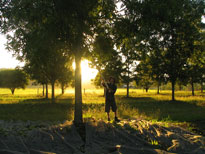 In 1995, Rod Daley decided to channel some of his spare energy into twenty acres of pecan nuts on his river flats near Kyogle. Rod has deep alluvial soils on his farm where in his spare time he runs a herd of good-looking Brahman cattle. This year Rod took a youthful team of men out to the farm to harvest his first commercial crop of pecans. I asked Paul Daley and Ben Riordan to take some photos of the process for me. As the cattle looked on curiously, the men shook each tree and gathered the nuts, four and a half tonnes of them.
In 1995, Rod Daley decided to channel some of his spare energy into twenty acres of pecan nuts on his river flats near Kyogle. Rod has deep alluvial soils on his farm where in his spare time he runs a herd of good-looking Brahman cattle. This year Rod took a youthful team of men out to the farm to harvest his first commercial crop of pecans. I asked Paul Daley and Ben Riordan to take some photos of the process for me. As the cattle looked on curiously, the men shook each tree and gathered the nuts, four and a half tonnes of them.
Rod has his trees spaced at 10m x 10m, this not only allows the trees ample growing room but it also leaves plenty of room to bring in the harvesting machinery. He has nearly one thousand trees of seven different varieties including, Mohawk, Shoshoni, Kiowa, Cape Fear, Pawnee, Cherokee and Sioux. Almost half of the trees are Shoshoni’s due to their prolific cropping habits and the high quality of the nuts. It was these trees that Rod was harvesting this year, the men collected nuts off six hundred of his trees, mostly Shoshoni. Pecan trees can produce twenty-five kilos of nuts per tree.
Rod has not harvested his pecans commercially before this year due to time constraints and the control of predators. Until this year, his sons have gathered the nuts from the ground and sold them locally for pocket money. The sulphur-crested cockatoos have also feasted on his pecans but they were in for a surprise this year when Rod decided the nuts were his. In order to secure, a bountiful harvest Rod first had to control the pests. As a rule, pecans are relatively pest and disease free, they are however relished by cockatoos and crows and if they are not kept away, they will strip the entire farm in no time. Both of these species of bird are very intelligent and in the case of cockatoos are very long lived so they will return year after year to a feeding site. Rod gave them a surprise this year. He purchased a gas gun as his method of control. This machine is a gas cannon that produces a very loud bang, it is set to begin firing just after daybreak. It fires every seven minutes for about one and a half hours. If the birds are kept away in the morning they usually stay away until the afternoon, so the process is repeated with the gun being set again the begin firing just before dusk. Rod also obtained a gun licence this year so that he can fire his shotgun at other times through the day keeping any scout birds away. It has been worth the effort as the first harvest shows.
Rod used a mechanical tree shaker to harvest his pecans; it attaches to the back of a tractor and vigorously shakes each tree. Hail netting was spread out below the tree to catch the nuts and three men were employed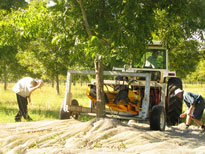 , driving the machinery, gathering the nuts and emptying the nuts from the netting into half tonne bins. This is a temporary method for the few harvests; the money received from this harvest will go towards purchasing, a silo to store the nuts, a new sorting shed and a nut harvester. Once the bins are full, they are taken to the sorting shed where the husks and any foreign matter are discarded. The nuts are then put on a bench with a fan that blows heat through them to dry them out. The moisture levels need to be reduced down to 7-8% to be accepted by the purchaser. They are sold in one tonne bags. This years premium pecan nuts are selling for $9.22 per kilo, choice nuts $4.60 and amber nuts are worth $3.24. Pecans can be stored in a cool dry place for twelve months.
, driving the machinery, gathering the nuts and emptying the nuts from the netting into half tonne bins. This is a temporary method for the few harvests; the money received from this harvest will go towards purchasing, a silo to store the nuts, a new sorting shed and a nut harvester. Once the bins are full, they are taken to the sorting shed where the husks and any foreign matter are discarded. The nuts are then put on a bench with a fan that blows heat through them to dry them out. The moisture levels need to be reduced down to 7-8% to be accepted by the purchaser. They are sold in one tonne bags. This years premium pecan nuts are selling for $9.22 per kilo, choice nuts $4.60 and amber nuts are worth $3.24. Pecans can be stored in a cool dry place for twelve months.
There are several secrets to successful growing of pecan trees; firstly, it is important to keep all weeds away from the trees especially in the first few years. Rod did this using roundup. An alternative method to using chemicals would be to spread a thick layer of mulch or compost to suppress the weeds. This method will also manage nutrient and water retention and maintain the correct balance of microorganisms, which is critical to soil health. Pecan trees will benefit from extra water in the first two years while they are establishing in the ground but after this time irrigation is not necessary. Rods trees are fertilised in spring with 2-3 kg of nitro phosphate fertiliser, this is the amount used for ten-year-old trees and will be increased as the trees mature. Applying nutrients in early spring will produce healthy and productive trees. If using an organic fertiliser such as blood and bone give it 4-5 weeks to break down, therefore late winter is the best time to apply it. Well-balanced compost rich in microorganisms is an excellent fertiliser. Rods cattle enjoy grazing under the pecans for most of the year until time to harvest; they keep the grass down and add their share of organic fertilizer. The other important job is pruning and shaping of the trees, this is especially important in their first few years.
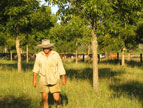 Rod chose pecans in the first place as a superannuation crop for himself and as an investment for his family and children. Pecan trees are perfectly suited to Rods land; they are also a very attractive and extremely long-lived tree. He wanted to leave something to his children and these trees will continue to produce nuts beyond their life span. They are a low maintenance crop that does not require spraying with chemicals. He also wanted a tree plantation where his cattle could graze.
Rod chose pecans in the first place as a superannuation crop for himself and as an investment for his family and children. Pecan trees are perfectly suited to Rods land; they are also a very attractive and extremely long-lived tree. He wanted to leave something to his children and these trees will continue to produce nuts beyond their life span. They are a low maintenance crop that does not require spraying with chemicals. He also wanted a tree plantation where his cattle could graze.
I asked Rod what his favourite nut is, he said, “Mohawk, it is a large nut that is easy to get into”. I will not be recommending Rods nut cracking technique as the only person he will impress will be his dentist. I have however discovered how to get the pecans out of the shell in two perfect halves. A firm wack with a wooden hammer on the top or bottom of the nut will split the sides; the halves are easily removed from their shell intact. We might have to get Rod a wooden hammer for Christmas.
Bush Food of the Month
Noni – Morinda citrifolia
Native to tropical coastal regions of the pacific including Australia, Asia, and Polynesia, the name Noni originates from Hawaii. Noni is a large shrub or medium sized tree; it can vary in height from 5 – 9 metres.
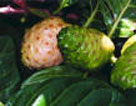 This wonderful tree produces a fruit with some very amazing properties. It seems strange to be recommending a fruit that tastes horrible but as we all know, foods that taste bad are often the most valuable to our bodies and Noni is defiantly this. Noni is also known as the cheese tree after the flavour of the fruit, which have been described as tasting, like blue cheese, one of the more flattering descriptions. The taste does not put people off as Noni is widely known for its remarkable healing qualities. When picked ripe the fresh Noni fruits already have a strong aroma. The fruits need to mature for a few days in a jar where the juice is collected. This process enhances the aroma. The liquid is strained and added to fresh water or juice and drunk to treat many ailments. It has been said that ‘if you are feeling ill or old this is the time to take the noni fruit.’(ref 1)
This wonderful tree produces a fruit with some very amazing properties. It seems strange to be recommending a fruit that tastes horrible but as we all know, foods that taste bad are often the most valuable to our bodies and Noni is defiantly this. Noni is also known as the cheese tree after the flavour of the fruit, which have been described as tasting, like blue cheese, one of the more flattering descriptions. The taste does not put people off as Noni is widely known for its remarkable healing qualities. When picked ripe the fresh Noni fruits already have a strong aroma. The fruits need to mature for a few days in a jar where the juice is collected. This process enhances the aroma. The liquid is strained and added to fresh water or juice and drunk to treat many ailments. It has been said that ‘if you are feeling ill or old this is the time to take the noni fruit.’(ref 1)
The Noni tree is a very attractive plant that is well suited to coastal regeneration in tropical areas. Noni is a perfect pioneer plant for shorelines where it protects sensitive, slower growing species. It is very hardy in its climatic region but is not tolerant of the cold. Anyone who wishes to grow this tree outside of the tropics will require a hot house to keep it alive over winter. It will tolerate poor soils, saline conditions and drought quite happily. Young leaves of the noni plant contain protein and can be eaten as a vegetable; the seeds are also edible when roasted. The bark of the tree is also used traditionally as a red, brown and yellow dye in the batik process.
Links:
http://www.naturia.per.sg/buloh/plants/morinda.htm
http://farrer.riv.csu.edu.au/ASGAP/m-cit.html
http://www.canoeplants.com/noni.html ( ref 1)
http://morinda.allbio.org/
Rainforest Plants of the Month
Silky Myrtle - Decaspermum humile
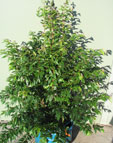 This lovely little tree is one of my favourites, it is a plant that always looks great and is suitable for a wide range of sites and soils. Silky myrtle is capable of reaching 8 metres but commonly seen as an attractive shrub 3-4 metres in height, which makes it a perfect landscaping specimen. This is a beautiful plant because its new growth is a delicate pink colour, covered in fine hairs it gives the whole shrub a shiny silky silvery look, truly stunning. Silky myrtle makes a perfect potted specimen or hedge plant and will look gorgeous all year round. In spring or summer, small white fluffy flowers cover the entire bush in producing a spectacular but short-lived show. Small black fruits follow and ripen in late winter. Silky myrtle is native to sub tropical and dry rainforest north from Ourimbah, where it is common on stony sites with poorer soils. The silky myrtle will tolerate less than ideal conditions, it is capable of handling light frosts, cool conditions and poor soils. Tip pruning and extra fertilizer will encourage the beautiful new growth and a more bushy form.
This lovely little tree is one of my favourites, it is a plant that always looks great and is suitable for a wide range of sites and soils. Silky myrtle is capable of reaching 8 metres but commonly seen as an attractive shrub 3-4 metres in height, which makes it a perfect landscaping specimen. This is a beautiful plant because its new growth is a delicate pink colour, covered in fine hairs it gives the whole shrub a shiny silky silvery look, truly stunning. Silky myrtle makes a perfect potted specimen or hedge plant and will look gorgeous all year round. In spring or summer, small white fluffy flowers cover the entire bush in producing a spectacular but short-lived show. Small black fruits follow and ripen in late winter. Silky myrtle is native to sub tropical and dry rainforest north from Ourimbah, where it is common on stony sites with poorer soils. The silky myrtle will tolerate less than ideal conditions, it is capable of handling light frosts, cool conditions and poor soils. Tip pruning and extra fertilizer will encourage the beautiful new growth and a more bushy form.
Chocolate Bliss Pecan Pie Recipe
• 1 package (8 squares) Baker's Semi-Sweet Baking Chocolate, divided
• 1 refrigerated pie crust (9 inch)
• 2 tablespoons butter or margarine
• 3 eggs, slightly beaten
• 1/4 cup firmly packed light brown sugar
• 1 cup corn syrup
• 1 teaspoon vanilla
• 1 1/2 cup Pecan Halves or Walnuts
COARSELY chop 4 squares of the chocolate; set aside. Line 9-inch pie plate with pie crust as directed on package.
MICROWAVE remaining 4 squares of chocolate and butter in large microwavable bowl on HIGH 1 to 2 minutes or until butter is melted. Stir until chocolate is completely melted.
BRUSH bottom of pie crust with small amount of beaten eggs. Stir remaining eggs, sugar, corn syrup and vanilla into chocolate mixture until well blended. Stir in nuts and chopped chocolate. Pour into pie crust.
BAKE at 350°F for 55 minutes or until knife inserted 2 inches from edge comes out clean. Cool on wire rack. Serve with thawed COOL WHIP Whipped Topping, if desired.
Recipe URL:
http://www.cdkitchen.com/recipes/recs/198/ChocolateBlissPecanPie63140.shtml
Submitted by:
Keri, Kansas, USA





